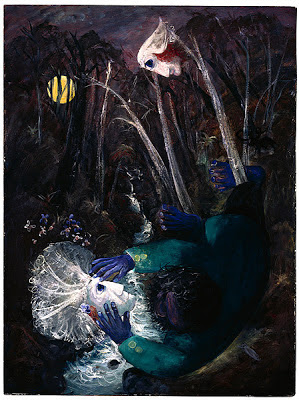I've now discovered some background to the work.
 |
| Arthur Boyd. Bride and Groom by a Creek. c.1960. Oil on composition board. 106.6 x 137.1cm. (http://www.ngv.vic.gov.au/col/work/75883) |
Arthur Boyd was born in 1920 in Murumbeena, now a suburb of Melbourne, Australia.
The name Murumbeena is thought to come from either the aboriginal words 'land of frogs', or possibly 'moss growing on decayed wood'.
His grandfather Arthur Merric Boyd was a well-known New Zealand landscape painter and although our Aurthur never had any formal art qualifications, he learnt from his grandfather. The whole of Arthur's family were very arty.
By the 1950's he and his brother, a ceramicist, were among the few Australian artists who were actually making a living from their art. Boyd's work was very popular among adventurous collectors, and he was on a retainer from the Australian Galleries to supply them with his work - especially of the landscapes around Wimmera and Berwick.
He would always grind his own pigments, and, rather than a palette, often used the palm of his hand to mix colours.
 |
| Wimmera landscape. 1950-52. |
 |
| Irrigation Lake, Wimmera. 1950 |
Many people, including his artist friends were troubled and bewildered when he moved away from this safe, Victorian landscape style and began to create troubling and uncomfortable-looking works. Although at this time he probably wouldn't have been familiar with the trends overseas, this untutored artist's work are immediately recognisable as expressionism, and he has been compared with Chagall and Norde. Many of his contemporaries couldn't understand why he would want to leave his previously successful style.
 |
| Reflected Bride 1 (Bride Reflected in a Creek) 1958. |
In 1960 he moved to England. (The top pinkish painting Bride and Groom by a Creek... was one of the first he painted in London.)
Now that they were in Europe, he and his lovely, protective wife Yvonne were able to see European art originals, and they also bought a house in Tuscany.
But where did the ideas from these disturbing new paintings come from?
From the NGV website:In 1951, Boyd visited Central Australia and witnessed the sad circumstances of the Indigenous people there. He travelled by the old Ghan train to Alice Springs and then by jeep to the former mining community of Arltunga. Before this time, as Grazia Gunn has recorded, he had only seen ‘one Aboriginal, a chap around Melbourne who played a gumleaf’.
Boyd was shocked and depressed to see the plight of Indigenous people. Their situation was not well known and he determined to show Australia that it had a moral responsibility to address such tragic neglect. Boyd was always the conscientious objector, the passionate protestor against inhumane treatment and acts of cruelty. He made many drawings of Indigenous people in his sketchbooks, but it was not until several years later that he began to make paintings based on them.
On the road to Alice Springs, Boyd had witnessed a truck carrying a group of Indigenous brides, whose white wedding finery contrasted sharply with the rudimentary vehicle normally used for transporting cattle. This memory was the origin of the ‘Love, marriage and death of a halfcaste’ series, better known as the ‘Bride’ series, an elaborate morality tale of an Indigenous trooper, a half-caste, and his half-caste bride. They are haunted by the dreamlike image of a white bride. For Boyd, the half-caste was the neglected outsider, neither black nor white, a nobody. His half-castes suffer the fate of the marginalised, isolated in a world of greed and selfishness.
Humphries, who used to visit him a lot, said in his biography of Boyd that 'he always had a more 'traditional' style landscape on his canvas', as a release from the increasingly powerful and allegorical expressionist works he was compelled to paint.
His full name was Arthur Merric Bloomfield Boyd and he died in 1999. He is survived by his wife and children Polly, Lucy and Jamie.


he has a delightfully sweet face
ReplyDeleteThanks for the explanation. Will your loyal readership be given more art appreciation tasks from NGV? I rather like these culturally uplifting challenges.
ReplyDeleteJohn - he does doesn't he? Perhaps sweet faces run deep.
ReplyDeleteYP. I do have another three from the NGV, if you think you could manage reading them. (I only looked at five works total)
I was amazed at how similar all our responses were to this one....
Had I been tempted into analysing the first picture I would never in a million years have come up with the explanation that Boyd gave.
ReplyDeleteHaving Reflect Bride 1 on my wall would give me nightmares of that I am reasonably certain.
PS I'd love to see the other works too.
ReplyDeleteGeeb - the pink softens the reading for me, but I still felt vaguely uncomfortable. Or, perhaps BECAUSE of the pink...
ReplyDeleteOther works coming. There's even a ceramic one just for you.
Thanks for the story and background of Arthur Boyd Katherine. I have not heard of him but will remember him now. Are any of his works in NZ that you know of? - Dave
ReplyDeleteYou're welcome Dave. I don't know if he has any works available for us to see in NZ, sorry. Google is your friend...
ReplyDelete